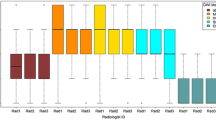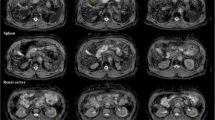Abstract
Purpose
The purpose of the study is to determine short-term reproducibility of apparent diffusion coefficient (ADC) estimated from diffusion-weighted magnetic resonance (DW-MR) imaging of the prostate.
Methods
Fourteen patients with biopsy-proven prostate cancer were studied under an Institutional Review Board-approved protocol. Each patient underwent two, consecutive and identical DW-MR scans on a 3T system. ADC values were calculated from each scan and a deformable registration was performed to align corresponding images. The prostate and cancerous regions of interest (ROIs) were independently analyzed by two radiologists. The prostate volume was analyzed by sextant. Per-voxel absolute and relative percentage variations in ADC were compared between sextants. Per-voxel and per-ROI variations in ADC were calculated for cancerous ROIs.
Results
Per-voxel absolute difference in ADC in the prostate ranged from 0 to 1.60 × 10−3 mm2/s (per-voxel relative difference 0% to 200%, mean 10.5%). Variation in ADC was largest in the posterior apex (0% to 200%, mean 11.6%). Difference in ADC variation between sextants was not statistically significant. Cancer ROIs’ per-voxel variation in ADC ranged from 0.001 × 10−3 to 0.841 × 10−3 mm2/s (0% to 67.4%, mean 11.2%) and per-ROI variation ranged from 0 to 0.463 × 10−3 mm2/s (mean 0.122 × 10−3 mm2/s).
Conclusions
Variation in ADC within the human prostate is reasonably small, and is on the order of 10%.


Similar content being viewed by others
References
Haider MA, van der Kwast TH, Tanguay J, et al. (2007) Combined T2-weighted and diffusion-weighted MRI for localization of prostate cancer. Am J Roentgenol 189(2):323–328
Tan CH, Wei W, Johnson V, Kundra V (2012) Diffusion-weighted MRI in the detection of prostate cancer: meta-analysis. Am J Roentgenol 199(4):822–829
Kajihara H, Hayashida Y, Murakami R, et al. (2009) Usefulness of diffusion-weighted imaging in the localization of prostate cancer. Int J Radiat Oncol Biol Phys 74(2):399–403
Oto A, Yang C, Kayhan A, et al. (2011) Diffusion-weighted and dynamic contrast-enhanced MRI of prostate cancer: correlation of quantitative MR parameters with gleason score and tumor angiogenesis. Am J Roentgenol 197(6):1382–1390
Rosenkrantz AB, Mannelli L, Kong XT, et al. (2011) Prostate cancer: utility of fusion of T2-weighted and high b-value diffusion-weighted images for peripheral zone tumor detection and localization. J Magn Reson Imaging 34(1):95–100
Lim HK, Kim JK, Kim KA, Cho K-S (2009) Prostate cancer: apparent diffusion coefficient map with T2-weighted images for detection-A Multireader study. Radiology 250(1):145–151
Woodfield CA, Tung GA, Grand DJ, et al. (2010) Diffusion-weighted MRI of peripheral zone prostate cancer: comparison of tumor apparent diffusion coefficient with Gleason score and percentage of tumor on core biopsy. Am J Roentgenol 194(4):W316–W322
Kitajima K, Kaji Y, Fukabori Y, et al. (2010) Prostate cancer detection with 3 T MRI: comparison of diffusion-weighted imaging and dynamic contrast-enhanced mri in combination with T2-weighted imaging. J Magn Reson Imaging 31(3):625–631
Mehta R, Kyshtoobayeva A, Kurosaki T, et al. (2001) Independent association of angiogenesis index with outcome in prostate cancer. Clin Cancer Res 7(1):81–88
Hosseinzadeh K, Schwarz SD (2004) Endorectal diffusion-weighted imaging in prostate cancer to differentiate malignant and benign peripheral zone tissue. J Magn Reson Imaging 20(4):654–661
Issa B (2002) In vivo measurement of the apparent diffusion coefficient in normal and malignant prostatic tissues using echo-planar imaging. J Magn Reson Imaging 16(2):196–200
Padhani AR, Liu G, Chenevert TL, et al. (2009) Diffusion-weighted magnetic resonance imaging as a cancer biomarker: consensus and recommendations. Neoplasia 11(2):102–125
Clarke LP, Croft BS, Nordstrom R, et al. (2009) Quantitative imaging for evaluation of response to cancer therapy. Transl Oncol 2(4):195–197
Sasaki M, Yamada K, Watanabe Y, et al. (2008) Variability in absolute apparent diffusion coefficient values across different platforms may be substantial: a multivendor, multi-institutional comparison study. Radiology 249(2):624–630
Sharp GC, Kandasamy N, Singh H, Folkert M (2007) GPU-based streaming architectures for fast cone-beam CT image reconstruction and demons deformable registration. Phys Med Biol 52(19):5771–5783
Chenevert TL, Galban CJ, Ivancevic MK, et al. (2011) Diffusion coefficient measurement using a temperature-controlled fluid for quality control in multicenter studies. J Magn Reson Imaging 34(4):983–987
Malyarenko D, Galban CJ, Londy FJ, et al. (2012) Multi-system repeatability and reproducibility of apparent diffusion coefficient measurement using an ice-water phantom. J Magn Reson Imaging 37(5):1238–1246
Braithwaite AC, Dale BM, Boll DT, Merkle EM (2009) Short- and midterm reproducibility of apparent diffusion coefficient measurements at 3.0-T diffusion-weighted imaging of the abdomen. Radiology 250(2):459–465
Kim SY, Lee SS, Byun JH, et al. (2010) Malignant hepatic tumors: short-term reproducibility of apparent diffusion coefficients with breath-hold and respiratory-triggered diffusion-weighted MR imaging. Radiology 255(3):815–823
Litjens GJS, Hambrock T, Hulsbergen-van de Kaa C, Barentsz JO, Huisman HJ (2012) Interpatient variation in normal peripheral zone apparent diffusion coefficient: effect on the prediction of prostate cancer aggressiveness. Radiology 265(1):260–266
Gibbs P, Pickles MD, Turnbull LW (2007) Repeatability of echo-planar-based diffusion measurements of the human prostate at 3 T. Magn Reson Imaging 25(10):1423–1429
Acknowledgement
This work was supported in part by the National Institute of Biomedical Imaging and Bioengineering of the National Institutes of Health under grant number T32 EB002103.
Author information
Authors and Affiliations
Corresponding author
Rights and permissions
About this article
Cite this article
Sadinski, M., Medved, M., Karademir, I. et al. Short-term reproducibility of apparent diffusion coefficient estimated from diffusion-weighted MRI of the prostate. Abdom Imaging 40, 2523–2528 (2015). https://doi.org/10.1007/s00261-015-0396-x
Published:
Issue Date:
DOI: https://doi.org/10.1007/s00261-015-0396-x




